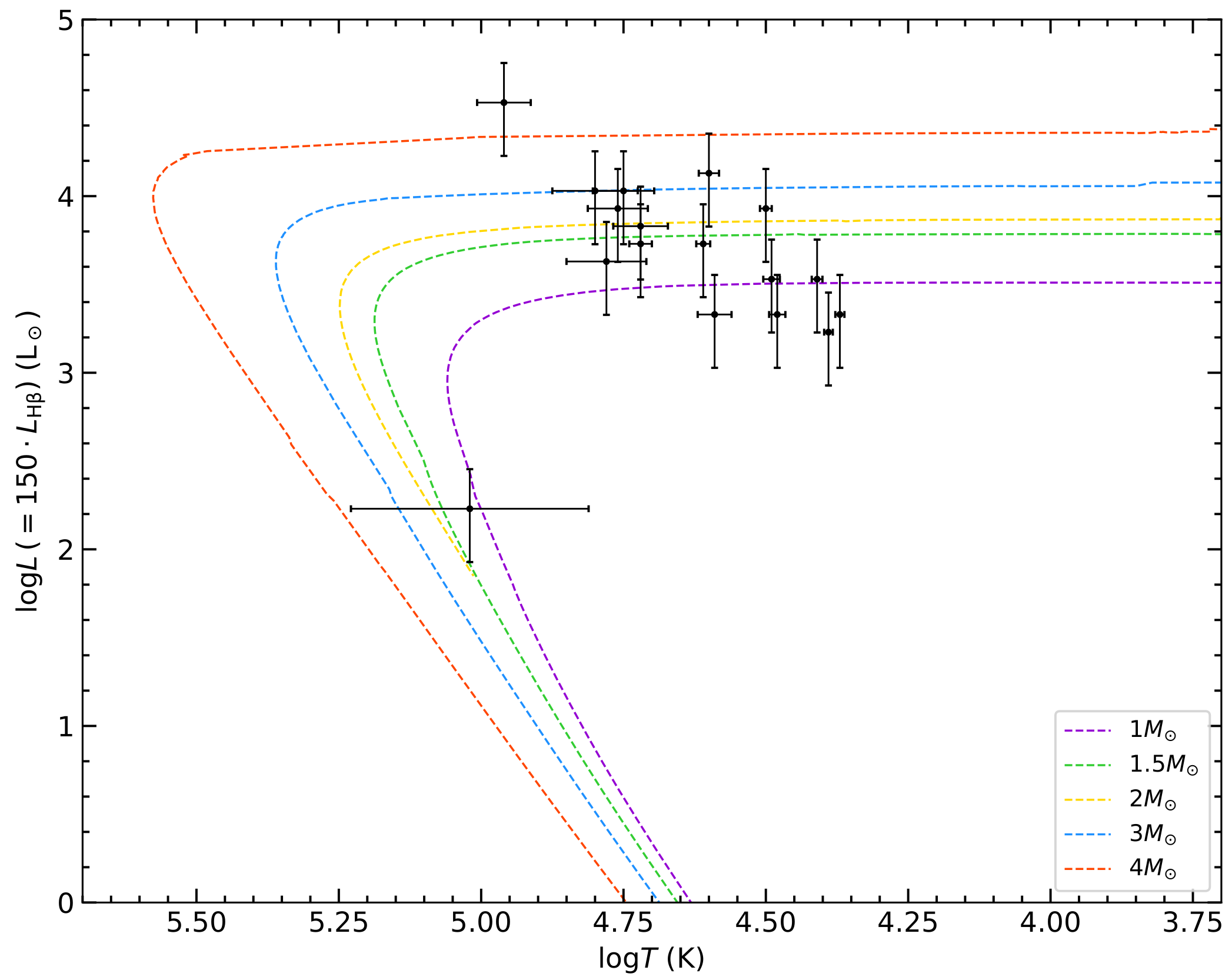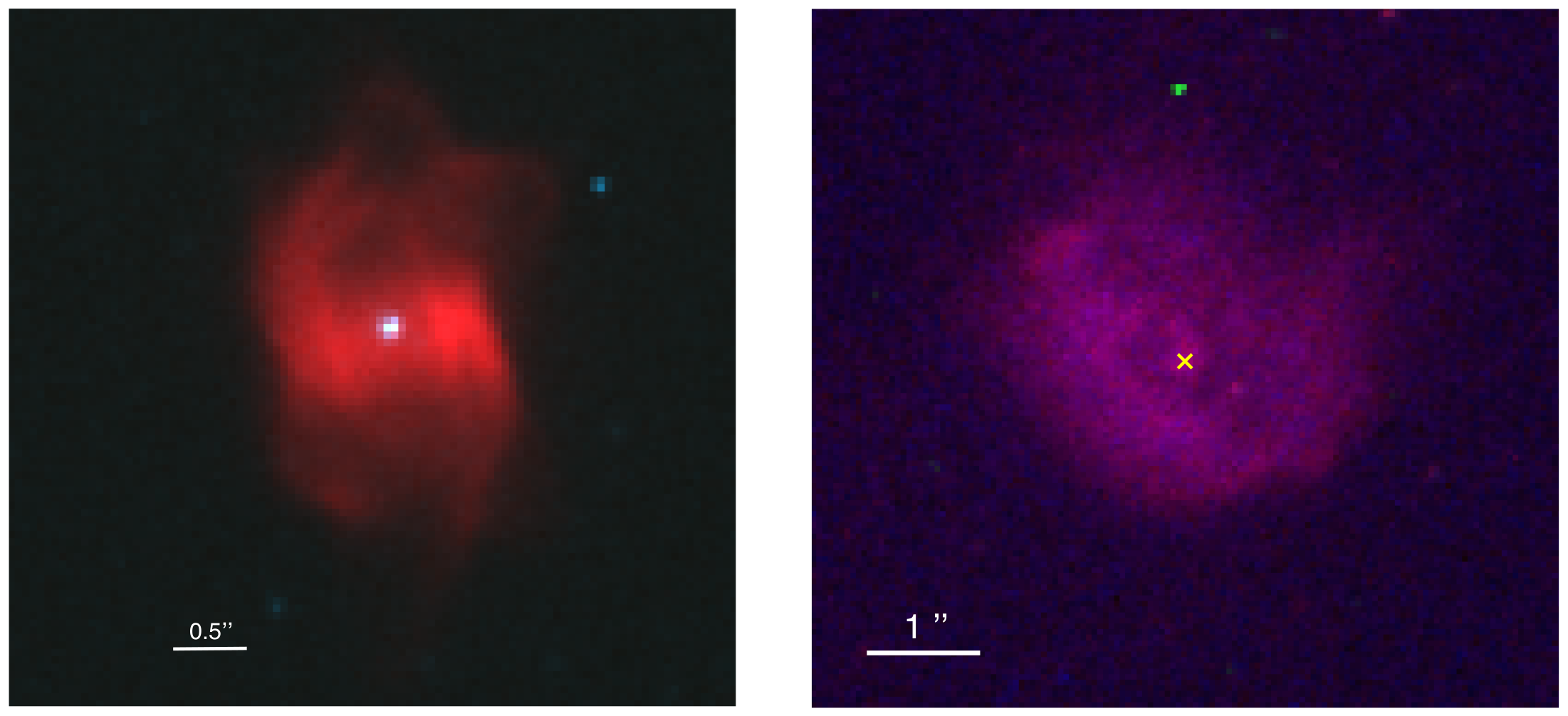On the Age of Galactic Bulge CSPNe: Too Young and Complicated?
Abstract
1. Introduction
2. Methods
2.1. From Hubble Space Telescope Images to Stellar Temperatures
2.2. CSPNe Luminosities
3. Results
4. Discussion and Future Work
Author Contributions
Funding
Conflicts of Interest
References
- Surot, F.; Valenti, E.; Hidalgo, S.L.; Zoccali, M.; Sökmen, E.; Rejkuba, M.; Minniti, D.; Gonzalez, O.A.; Cassisi, S.; Renzini, A.; et al. Mapping the stellar age of the Milky Way bulge with the VVV. I. The method. A&A 2019, 623, A168. [Google Scholar] [CrossRef]
- Miller Bertolami, M.M. New models for the evolution of post-asymptotic giant branch stars and central stars of planetary nebulae. A&A 2016, 588, A25. [Google Scholar] [CrossRef]
- Acker, A.; Raytchev, B.; Koeppen, J.; Stenholm, B. An extensive study of planetary nebulae in the galactic bulge. A& AS 1991, 89, 237. [Google Scholar]
- Zanstra, H. An Application of the Quantum Theory to the Luminosity of Diffuse Nebulae. ApJ 1927, 65, 50. [Google Scholar] [CrossRef]
- Luridiana, V.; Morisset, C.; Shaw, R.A. PyNeb: A new tool for analyzing emission lines. I. Code description and validation of results. A&A 2015, 573, A42. [Google Scholar] [CrossRef]
- Pottasch, S.R. Planetary nebulae. A study of late stages of stellar evolution. In Astrophysics and Space Science Library; Reidel: Dordrecht, The Netherlands, 1984. [Google Scholar]
- Frew, D.J.; Parker, Q.A.; Bojicic, I. The Hα surface brightness-radius relation: A robust statistical distance indicator for planetary nebulae. MNRAS 2016, 455, 1459. [Google Scholar] [CrossRef]
- Gaia Collaboration. Gaia Data Release 2. Summary of the contents and survey properties. A&A 2018, 616, A1. [Google Scholar] [CrossRef]
- Zijlstra, A.A.; Pottasch, S. Low mass planetary nebulae near the galactic centre. A&A 1989, 216, 245. [Google Scholar]
- Gesicki, K.; Zijlstra, A.A.; Hajduk, M.; Szyszka, C. Accelerated post-AGB evolution, initial-final mass relations, and the star-formation history of the Galactic bulge. A&A 2014, 566, A48. [Google Scholar] [CrossRef]
- Parker, Q.A.; Phillipps, S.; Pierce, M.J.; Hartley, M.; Hambly, N.C.; Read, M.A.; MacGillivray, H.T.; Tritton, S.B.; Cass, C.P.; Cannon, R.D.; et al. The AAO/UKST SuperCOSMOS Hα survey. MNRAS 2005, 362, 689. [Google Scholar] [CrossRef]
- Kaller, J.B.; Jacoby, G.H. Central Star Temperatures of Low-Excitation Planetary Nebulae. ApJ 1991, 372, 215. [Google Scholar] [CrossRef]
| 1 | |
| 2 | This discrepancy will be further investigated in the future with the comparison to model atmospheres. |
| 3 | A few CSPNe were found in the Gaia Data Release 2, however either the distances are highly unreliable or Gaia has detected nebular features. Therefore, we draw caution to the current Gaia detections for such distant sources, as we have noticed that in some cases, where the nebula is less than 3″ in size, Gaia astrometry indicates that the detected “source” is either a nebular feature or a nearby star. This discrepancy could only be found whilst comparing current Gaia astrometry to high-angular resolution images such as the ones here. |
| 4 | Nevertheless, 4 CSPNe in our sample are positioned slightly below the 1 M track. Unless their distances are larger than 10 kpc, the discrepancy in their positions might result from an erroneous assumption that these nebulae are optically thick to ionizing radiation. |
| 5 | The final sample will consist 40 CSPNe for which we have HST data. |
| 6 | Nebular spectra are available in the literature, however these are of low spectral resolution and perhaps not centered on the CSPNe. |
| 7 |


| Name | (mag) | (K) | (L) | ||
|---|---|---|---|---|---|
| H2-20 | 14.42 | 0.18 | 4.49 | 0.02 | 3.53 |
| H2-17 | 14.46 | 0.12 | 4.39 | 0.01 | 3.21 |
| H2-25 | 13.72 | 0.13 | 4.37 | 0.01 | 3.32 |
| M1-20 | 15.41 | 0.17 | 4.72 | 0.02 | 3.73 |
| M1-31 | 16.32 | 0.30 | 4.96 | 0.05 | 4.53 |
| M1-19 | 15.15 | 0.12 | 4.61 | 0.01 | 3.72 |
| H1-8 | 16.68 | 0.56 | 4.80 | 0.08 | 4.03 |
| H1-9 | 13.76 | 0.13 | 4.50 | 0.01 | 3.91 |
| H1-46 | 13.57 | 0.18 | 4.60 | 0.02 | 4.12 |
| M3-40 | 13.85 | 0.14 | 4.41 | 0.01 | 3.52 |
| H2-13 | 17.43 | 0.54 | 4.78 | 0.07 | 3.63 |
| MaC1-11 | 15.35 | 0.18 | 4.48 | 0.01 | 3.32 |
| K5-4 | 16.66 | 0.43 | 4.75 | 0.05 | 4.03 |
| Th3-6 | 16.44 | 0.31 | 4.59 | 0.03 | 3.32 |
| Th3-4 | 16.94 | 0.42 | 4.76 | 0.05 | 3.92 |
| H1-19 | 16.82 | 0.40 | 4.72 | 0.05 | 3.82 |
| H2-15 | 21.68 | 1.19 | 5.02 | 0.21 | 2.23 |
© 2020 by the authors. Licensee MDPI, Basel, Switzerland. This article is an open access article distributed under the terms and conditions of the Creative Commons Attribution (CC BY) license (http://creativecommons.org/licenses/by/4.0/).
Share and Cite
Lykou, F.; Zijlstra, A.; Parker, Q.A. On the Age of Galactic Bulge CSPNe: Too Young and Complicated? Galaxies 2020, 8, 51. https://doi.org/10.3390/galaxies8020051
Lykou F, Zijlstra A, Parker QA. On the Age of Galactic Bulge CSPNe: Too Young and Complicated? Galaxies. 2020; 8(2):51. https://doi.org/10.3390/galaxies8020051
Chicago/Turabian StyleLykou, Foteini, Albert Zijlstra, and Quentin A. Parker. 2020. "On the Age of Galactic Bulge CSPNe: Too Young and Complicated?" Galaxies 8, no. 2: 51. https://doi.org/10.3390/galaxies8020051
APA StyleLykou, F., Zijlstra, A., & Parker, Q. A. (2020). On the Age of Galactic Bulge CSPNe: Too Young and Complicated? Galaxies, 8(2), 51. https://doi.org/10.3390/galaxies8020051






